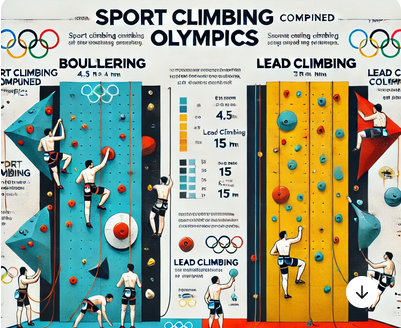As sport climbing continues to gain global attention—especially after its Olympic debut—many are curious about how the competition works. From the equipment climbers must wear to how they score points, here’s everything you need to know about Olympic sport climbing rules, regulations, and scoring.
📊 Diagram: Olympic Sport Climbing Rules & Scoring Overview
⚖️ Olympic Disciplines Explained
Speed Climbing
-
Athletes race up a 15-meter wall set at a 95-degree angle.
-
Identical routes for every competitor.
-
Fastest time wins.
Bouldering
-
Climbers solve short, complex problems (routes) on a 4.5m wall without ropes.
-
Limited time (usually 4 minutes) per problem.
-
Scoring based on reaching “zone” and “top” holds.
Lead Climbing
-
One long route on a 15+ meter wall.
-
Climbers are tied into a rope and have one attempt to climb as high as possible within 6 minutes.
-
Highest hold reached earns points.
🧵 General Safety and Conduct Rules (Inspired by Traditional Rock Climbing)
These universal rules also influence how Olympic sport climbing is safely regulated:
-
Smooth Lowering: Climbers must lower themselves slowly and under control to avoid injury.
-
Proper Attachment: Climbers must be securely attached to the rope using approved knots and harnesses.
-
Mandatory Helmets: Helmets are often required during training or lead climbing supervision (especially for youth).
-
No Rope Swinging: Swinging can harm other climbers or damage holds and gear.
-
Supervised Lead Climbing Only: Lead climbing is only allowed during supervised times/events.
-
No High Bouldering Without Spotting: Above 3 meters, climbers must use crash pads and have spotters.
-
Double-Check Gear: Both the climber and belayer must check harnesses, buckles, and knots before each climb.
🔍 Scoring System Breakdown
Bouldering Scoring
-
Top Hold: Maximum score.
-
Zone Hold: Partial points.
-
Attempts Count: Fewer attempts = better score.
-
Prioritized: Top → Zone → Attempts to Top → Attempts to Zone
Lead Scoring
-
Point per Hold: Each hold is worth 1 point.
-
Plus (+) if the climber uses the next hold but doesn’t fully secure it.
-
Tiebreakers often come down to who got higher earlier (in bouldering or speed rounds).
🛡️ Equipment Regulations
-
Harness: Must be properly adjusted and double-backed.
-
Ropes: Must meet safety standards and be correctly tied in (e.g., figure-eight knot with backup).
-
Chalk: Allowed for grip, but liquid chalk is often required for cleanliness.
-
Climbing Shoes: Required for all Olympic climbing disciplines.
🕵️ Fair Play & Rules Enforcement
-
Route Preview: Climbers can view but not touch the route beforehand.
-
Time Limit: All climbs are timed.
-
No Communication: Coaches cannot assist during a climb.
-
Officials: Monitor for rule violations and safety infractions.
